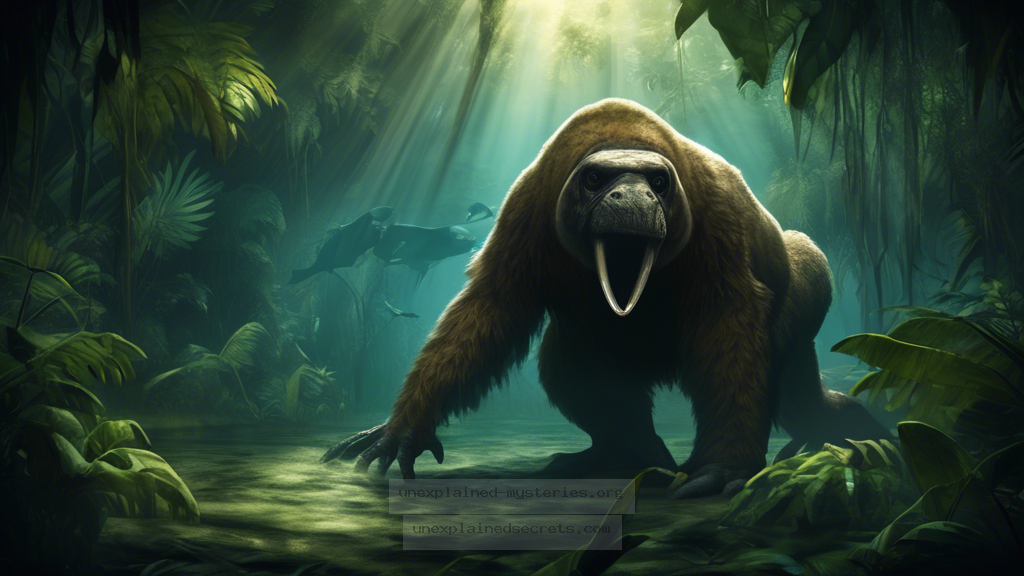What Lies Beneath the Shadows of the Amazon: Is the Mapinguari the Missing Link to Extinct Megafauna?
What Lies Beneath the Shadows of the Amazon: Is the Mapinguari the Missing Link to Extinct Megafauna?
The Amazon rainforest is a realm of breathtaking beauty and profound mystery, home to countless species yet to be discovered. Among these mysteries lies the legend of the Mapinguari, a cryptid said to roam the dense underbrush, evoking both fear and fascination. This question is pivotal not only for cryptozoologists but also for anthropologists and ecologists, as it intersects with theories regarding megafauna extinction and the ecological tapestry of the Amazon. What exactly is the Mapinguari, and could it possibly be a remnant of the prehistoric giants that once ruled this landscape? Let’s delve into this captivating enigma.
The Legend of the Mapinguari
The Mapinguari is described variably as a giant sloth-like creature, standing up to 10 feet tall, with long claws and a distinct odor reminiscent of rotting flesh. Indigenous tribes in the Amazon have spoken of this beast for centuries, often depicting it as a guardian of the forest. The creature is said to possess a single eye in the center of its forehead and a mouth on its belly, leading to various interpretations of its feeding habits and behavior. Reports of the Mapinguari have emerged from regions across Brazil, Peru, and even Bolivia, with the first documented sightings traced back to the early 20th century.
Historical Context of Megafauna in South America
During the Pleistocene epoch, South America was home to an array of megafauna, including giant ground sloths, saber-toothed cats, and massive rodents like the megatherium. The extinction of these creatures is a topic of ongoing debate, with theories ranging from climate change to human hunting practices. The persistence of the Mapinguari legend raises questions about whether some of these ancient species may have survived into modern times, cloaked in myth and obscured by the dense greenery of the Amazon.
Core Concepts and Theories Surrounding the Mapinguari
Many theories abound regarding the identity of the Mapinguari. Some researchers suggest it may be a surviving giant ground sloth, while others propose it could be a previously unknown species of primate or a misidentified animal such as a capybara. The concept of surviving megafauna is not unique to the Amazon; numerous regions around the world claim their own cryptids, often linked to the remnants of extinct species. The Mapinguari could be an amalgamation of various local fauna, exaggerated through folklore.
Practical Evidence and Sightings
Numerous sightings have been reported throughout the Amazon, with some witnesses claiming to have encountered the creature directly. For instance, in 2007, a Brazilian expedition team claimed to have found tracks in the mud that they attributed to the Mapinguari, sparking media attention and renewed interest in the cryptid. However, these claims often lack substantial photographic or biological evidence, leading to skepticism in the scientific community. The challenge of investigating such a remote area makes it difficult to obtain concrete proof.
Comparing the Mapinguari to Other Cryptids
The Mapinguari is not the only cryptid to capture the imagination and curiosity of researchers and enthusiasts alike. Here’s a comparison with some notable other cryptids:
| Cryptid | Location | Description | Similarities to Mapinguari |
|---|---|---|---|
| Bigfoot | North America | A large, hairy humanoid | Both are elusive and have numerous reported sightings |
| Yeti | The Himalayas | A creature resembling a large ape | Both are linked to folklore and remote habitats |
| Chupacabra | Latin America | A creature known for attacking livestock | Both are associated with fear and local legends |
Alternative Perspectives on the Mapinguari
While many enthusiasts fervently believe in the existence of the Mapinguari, there are alternative perspectives that warrant consideration. Skeptics argue that the creature is a product of folklore and exaggerated storytelling, perhaps a means for indigenous cultures to explain mysterious phenomena in their environment. Additionally, some anthropologists contend that the tales of the Mapinguari may serve social functions within tribes, fostering a sense of shared identity and cultural heritage.
Common Misconceptions About the Mapinguari
There are several misconceptions surrounding the Mapinguari that can cloud our understanding. One common belief is that the creature is a direct descendant of prehistoric sloths, leading to assumptions about its behavior and habitat. While it could be an evolutionary remnant, the lack of physical evidence makes it difficult to draw definitive conclusions. Moreover, many assume that the Mapinguari is a solitary creature; however, indigenous narratives often describe it as part of a larger ecosystem, interacting with various species.
Best Practices for Investigating Cryptids
For those intrigued by the possibility of cryptids like the Mapinguari, it’s essential to approach investigations with a blend of skepticism and open-mindedness. Here are some best practices for conducting research:
- Gather evidence: Document sightings and collect physical evidence such as hair samples or footprints, ensuring proper scientific methods are followed.
- Engage with local communities: Learning from indigenous populations can provide insights into local lore and potential sightings.
- Utilize technology: Employ modern tools like drones and camera traps to cover vast and challenging terrains.
- Collaborate with experts: Work with biologists and ecologists to understand the local fauna and flora, which can help in identifying potential misidentifications.
Future Developments and Ongoing Research
The study of cryptids like the Mapinguari is evolving, with advances in technology and methodologies enhancing our understanding of unexplained phenomena. Genetic analysis tools, such as environmental DNA (eDNA) sampling, could potentially reveal the presence of unknown species in the Amazon. Furthermore, collaborations between cryptozoologists and mainstream scientists are becoming more common, fostering a productive dialogue about the possibility of uncovering new species and the ecological implications thereof.
Conclusion
The mystery of the Mapinguari remains unsolved, inviting both intrigue and skepticism. While it may represent a living relic of extinct megafauna, it also encapsulates the cultural narratives of the indigenous tribes of the Amazon. As we continue to explore this enigmatic wilderness, the possibility of uncovering new truths about the Mapinguari and its connection to our planet’s prehistoric past becomes ever more tantalizing. Whether it is a myth or a reality, the Mapinguari serves as a reminder of the wonders still hidden within our world, challenging us to look beyond the ordinary and embrace the extraordinary.
Other Articles
Recent Posts
- What Happened to Flight MH370? The Conspiracy Theories That Still Haunt Us
- What Secrets Lurk Within the Walls of the Infamous Trans-Allegheny Lunatic Asylum?
- What Evidence Supports the Existence of Bigfoot in the Pacific Northwest?
- What Happened to the Indus Valley Civilization? Unraveling the Mysteries of Ancient Urban Life
- Can Telepathy Be Scientifically Proven Through Laboratory Evidence?







